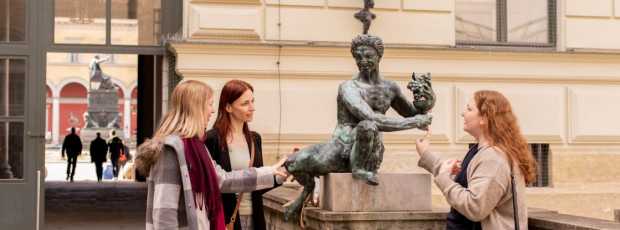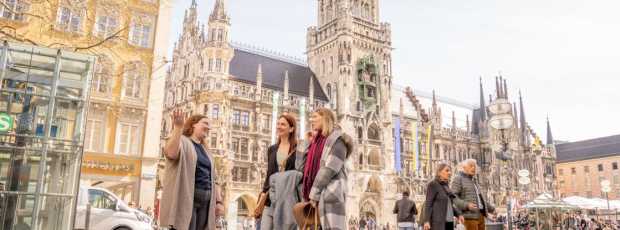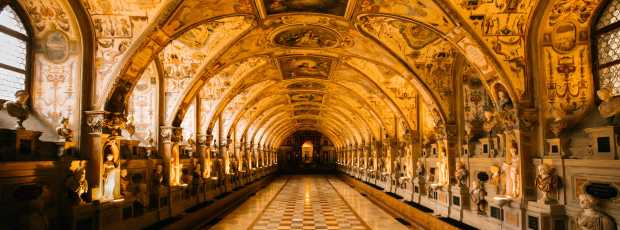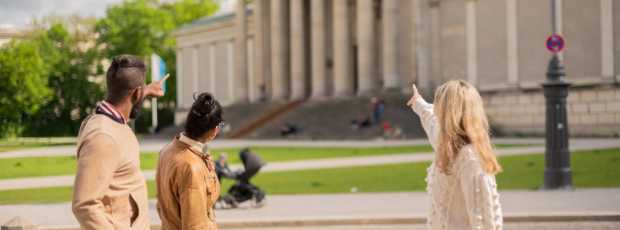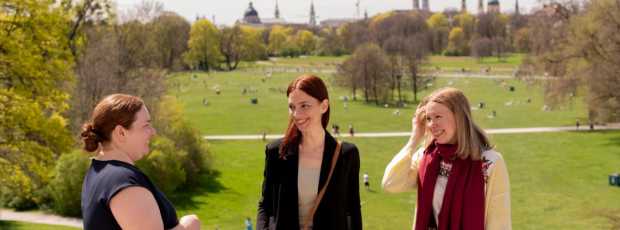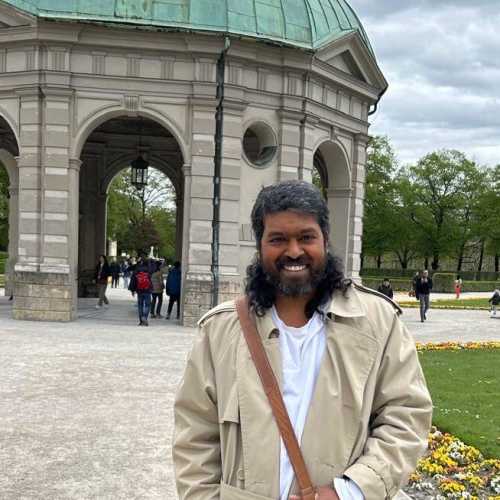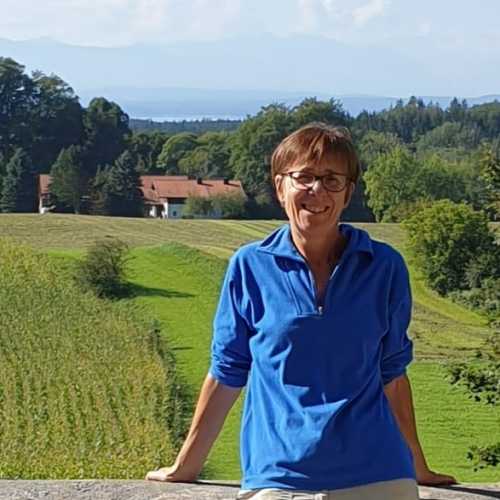Table Of Contents
- Where to Start Your One Day in Munich
- Is Munich Walkable for a One-Day Visit?
- Morning: The Heart of Munich's Old Town
- Exploring Munich's Religious Heritage
- Mid-Morning: Munich Residenz and Royal History
- Late Morning: Viktualienmarkt Food Experience
- Midday: English Garden and Urban Nature
- Surfing in the City: Eisbach River Phenomenon
- Afternoon: Exploring Beyond the Center
- Late Afternoon: Alternative Munich Neighborhoods
- Evening: Traditional Beer Gardens and Local Culture
- Seasonal Considerations for Your Munich Day
- Transportation Tips for Your Munich Day Trip
- Food and Dining During Your Munich Day
- Making the Most of Limited Time
- Weather-Appropriate Planning
- Hidden Gems and Local Secrets
- Connecting with Munich's Contemporary Culture
- Practical Considerations for Day Visitors
- Photography Tips for Your Munich Day
- Budget-Friendly Strategies for Munich
- Conclusion: Is One Day in Munich Enough?
A well-planned day in Munich can cover the city's most significant historical sites, offer genuine local experiences, and provide that authentic Bavarian atmosphere everyone seeks. The secret is knowing which corners to turn, which shortcuts to take, and where to pause for those moments that transform a rushed tourist checklist into meaningful travel memories.
Where to Start Your One Day in Munich
The city's location makes it the perfect if you have many places to go in Munich in your itinerary. The city center operates like a well-orchestrated symphony, with each district flowing naturally into the next. Most first-time visitors benefit from beginning at Marienplatz, Munich's main square, which serves as both geographical and cultural heart of the old town.
The beauty of visiting Munich lies in its compact city centre. Unlike sprawling metropolises, Munich's historical core remains wonderfully walkable. From Marienplatz, you can reach most major attractions within a 15-minute walk, making it entirely feasible to explore Munich without relying heavily on public transport.
Starting early, around 8:30 AM, gives you the advantage of experiencing Munich before the tourist crowds arrive. The morning light catches the Gothic spires beautifully, and you'll have better opportunities for photographs without having to navigate around tour groups. This timing also aligns perfectly with traditional Bavarian breakfast customs.
Is Munich Walkable for a One-Day Visit?
Munich consistently ranks as one of Europe's most walkable cities, and this reputation proves especially valuable when you're trying to maximize one day in Munich. The old town's medieval street pattern, though occasionally confusing, keeps distances surprisingly short. Most attractions cluster within what locals call the "inner ring," bounded by the former city walls.
The pedestrian zones throughout Munich's city center eliminate traffic concerns and create pleasant walking conditions. From the main train station to Marienplatz, the walk takes roughly 12 minutes through covered passages and wide boulevards. The route offers glimpses of both modern Munich and its historical foundations.
Weather rarely poses significant challenges for walking in Munich. The city's urban planning includes covered walkways, arcades, and indoor passages that connect major shopping areas. Even during brief rain showers, you can continue moving between attractions without major disruptions.
Public transportation remains readily available should you need it. Munich's U-Bahn and S-Bahn systems connect seamlessly with walking routes, allowing you to extend your day trip beyond the immediate city center if time permits.
Looking for a private city experience in Munich?
Explore the city with a local who plans a private day just for you; no groups, no scripts.
Morning: The Heart of Munich's Old Town
Begin your day in Munich at Marienplatz, Munich's central square and the perfect starting point for any Munich itinerary. This iconic plaza has served as the city's focal point since 1158, when Henry the Lion established Munich at this strategic crossing of trade routes. The square's name honors the Marian column erected in 1638, celebrating the city's survival during the Swedish occupation.
The new town hall dominates the northern side of Marienplatz with its elaborate Gothic Revival architecture. Despite its medieval appearance, this impressive structure dates only to the early 20th century. The building houses Munich's city government and features the world famous glockenspiel that performs daily at 11 AM, 12 PM, and during summer months at 5 PM.
The famous glockenspiel depicts two historical events: a tournament held in Marienplatz in 1568 and the Schäfflertanz, a traditional dance performed by barrel makers. Forty-three bells and 43 figures create this mechanical theater, entertaining visitors with scenes from Munich's past. The performance lasts approximately 15 minutes and provides an excellent introduction to Bavarian traditions.
The old town hall, located at the eastern end of Marienplatz, presents a stark contrast to its newer neighbor. This 15th-century building survived World War II bombing and now houses the toy museum in its tower. The building's simple Gothic lines and red-tiled roof represent Munich's authentic medieval architecture.
Climbing the city hall tower offers panoramic views across Munich's old town and provides perspective on the city's layout. The elevator ride costs a modest fee, but the vista encompasses the distinctive onion domes of Frauenkirche, the English Garden's green expanse, and on clear days, the Bavarian Alps' distant peaks.
Exploring Munich's Religious Heritage
Just steps from Marienplatz stands Alter Peter, affectionately known as Peter's church by locals. This structure claims the distinction of being Munich's oldest church, with foundations dating to the 11th century. The current building reflects centuries of modifications, creating a fascinating architectural palimpsest that tells Munich's religious story.
The church tower, locally called "Old Peter," requires climbing 299 steps to reach the viewing platform. This physical challenge rewards visitors with arguably Munich's best urban vista. The south tower provides unobstructed views across the central square and deep into the surrounding neighborhoods.
Local legend speaks of the legendary devil's footstep visible in the church floor near the entrance. According to Munich folklore, the devil visited the church and left his mark in the stone, creating the mysterious black footprint that still puzzles visitors today. Whether you believe the supernatural explanation or prefer geological rationality, the marking adds mystique to this ancient sacred space.
From Alter Peter, a short walk leads to Frauenkirche, Munich's cathedral and most recognizable landmark. The twin towers with their distinctive onion domes have defined Munich's skyline since the 15th century. These green copper domes, added in the 16th century, replaced the original Gothic spires and created Munich's most photographed silhouette.
The cathedral's interior surprises visitors with its stark simplicity compared to the ornate baroque churches found elsewhere in Bavaria. This Lutheran influence reflects Munich's complex religious history and provides a contemplative atmosphere for reflection during your busy day in Munich.
Mid-Morning: Munich Residenz and Royal History
A five-minute walk from Marienplatz brings you to Max Joseph Platz and the Munich Residenz, former palace of Bavarian monarchs. This vast complex served as the seat of power for the House of Wittelsbach from 1385 to 1918, making it one of Europe's most significant royal residences.
The Residenz encompasses multiple architectural styles accumulated over six centuries of construction and renovation. Renaissance courtyards blend with baroque state rooms and neoclassical facades, creating a comprehensive survey of European palace architecture. Each section reflects the tastes and ambitions of different rulers who called this complex home.
The Residenz Museum contains over 130 rooms open to public viewing, though visiting every chamber would consume your entire day in Munich. Focus on the Antiquarium, Europe's largest Renaissance hall, and the Treasury, which houses the Bavarian crown jewels and religious artifacts collected over centuries.
The Court Garden behind the Residenz provides a peaceful interlude between museum visits. This formal baroque garden, designed in the 17th century, features geometric layouts, fountains, and seasonal flower displays. The garden offers benches where you can rest while planning the next portion of your Munich itinerary.
King Ludwig I transformed much of Munich during his 19th-century reign, and his influence appears throughout the Residenz complex. His additions include neoclassical elements that harmonize surprisingly well with earlier architectural periods, demonstrating the continuity of Bavarian royal patronage.
What if your day in Munich was planned by someone who knows it — and you?
City Unscripted matches you with a local host who creates a private experience based on your interests, not a set route.
Late Morning: Viktualienmarkt Food Experience
No authentic day in Munich would be complete without experiencing Viktualienmarkt, the city's premier food market located just south of Marienplatz. This daily market has operated since 1807, evolving from a simple farmers' market into Munich's gourmet epicenter while maintaining its local character and traditional atmosphere.
The market's 140 stalls offer everything from fresh fruits and regional specialties to international delicacies. Local vendors, many representing families who have worked here for generations, provide expert advice on seasonal produce and traditional Bavarian ingredients. This personal connection distinguishes Viktualienmarkt from impersonal supermarket shopping.
Traditional bavarian food finds its finest expression at Viktualienmarkt's prepared food stalls. Sample weisswurst (white sausage) with sweet mustard and fresh pretzels, or try leberkäse (though despite its name, it contains neither liver nor cheese). These local specialties provide authentic flavors without requiring a full restaurant meal.
Wonderful local products include handmade pasta, artisanal honey, regional wines, and seasonal specialties that reflect Bavaria's agricultural calendar. Many vendors offer samples, allowing you to discover flavors unique to this region. This interactive experience adds educational value to your Munich trip.
The market's central location makes it an ideal stopping point during any Munich itinerary. Whether you need provisions for a picnic in the English Garden or simply want to experience local commerce, Viktualienmarkt provides authentic encounters with Munich's culinary culture.
Midday: English Garden and Urban Nature
After exploring Munich's historical core, the English Garden offers a dramatic change of pace and scenery. This vast urban park, larger than New York's Central Park, provides green refuge in the heart of this big city. Created in 1789, the garden demonstrates Munich's early commitment to public recreation and urban planning.
The park's name reflects its naturalistic landscape design, contrasting with formal French garden styles popular during the 18th century. Winding paths, meadows, and mature tree groves create an idealized countryside within Munich's urban boundaries. This design philosophy influenced park creation throughout Europe.
Live music performances occur regularly at the Chinese Tower, particularly on weekends and holidays. Traditional Bavarian brass bands, folk musicians, and seasonal concerts add soundtrack to your English Garden experience. The acoustic qualities of the open-air venue enhance the authentic beer garden atmosphere.
Surfing in the City: Eisbach River Phenomenon
One of Munich's most unexpected attractions awaits along the Eisbach river, where urban river surfing has become a local institution. This phenomenon, unique among European cities, demonstrates Munich's innovative spirit and residents' creative approach to urban recreation.
The artificial wave forms where the Eisbach river passes under Prinzregentenstraße bridge. Water channeled through concrete structures creates a standing wave perfect for surfing, though the activity requires considerable skill and experience. River surfers line the banks daily, waiting their turn to attempt rides on this challenging urban wave.
Watching the river surfers provides entertainment even if you don't participate personally. The skill level required amazes observers, as surfers navigate the narrow channel while maintaining balance against the constant current. Spectators gather on the bridge above, creating an impromptu viewing gallery for this unique Munich spectacle.
This activity demonstrates Munich's capacity for innovation within traditional settings. The English Garden, designed in the 18th century for peaceful contemplation, now hosts one of the world's most unusual urban sports venues. This evolution reflects Munich's ability to adapt historical spaces for contemporary uses.
Tip
We match you with the right host, not just any guide.Want to experience the real Munich with someone who lives there?
A fully private experience, planned and led by a local host who tailors the day to you
Afternoon: Exploring Beyond the Center
With the afternoon hours of your day in Munich, consider venturing slightly beyond the immediate city center to experience Munich's diversity. The Olympic Park, site of the 1972 Summer Olympics, offers both historical significance and recreational opportunities within easy reach of downtown Munich.
Olympic Park's innovative architecture, particularly the transparent acrylic glass roof system, represented cutting-edge design during the 1970s. The complex continues hosting major sporting events, concerts, and cultural activities, maintaining its relevance decades after the original Olympic Games concluded.
The park's central location makes it accessible via public transportation, requiring approximately 20 minutes from Marienplatz. This journey gives you experience with Munich's efficient U-Bahn system while expanding your geographical understanding of the city's layout and development patterns.
Alternatively, spend your afternoon exploring Munich's museum quarter, which houses several world-class institutions. The Deutsches Museum, located on an island in the Isar River, claims to be the world's largest technology museum. Its collections span scientific and technological development from ancient times to contemporary innovations.
The museum's exhibits include original aircraft, historic automobiles, pharmaceutical development, and interactive demonstrations that engage visitors of all ages. Plan at least two hours if you choose to include this technology museum in your Munich itinerary, though dedicated enthusiasts could easily spend an entire day exploring its comprehensive collections.
Late Afternoon: Alternative Munich Neighborhoods
Exploring neighborhoods beyond the tourist core reveals Munich's authentic character and contemporary culture. The Glockenbachviertel, located southwest of the city center, offers boutique shopping, cafes, and restaurants that cater primarily to local residents rather than tourists.
This district's relaxed atmosphere contrasts sharply with Marienplatz's constant activity. Tree-lined streets, independent businesses, and neighborhood pubs create an environment where you can observe daily Munich life without tourist overlay. Many locals consider this area Munich's most livable neighborhood.
The Maxvorstadt district, home to Munich's university and numerous museums, presents another facet of the city's character. Art galleries, bookshops, and student hangouts create an intellectual atmosphere that complements Munich's reputation as a cultural center.
Both neighborhoods remain easily accessible from the city center via public transportation or extended walking. Including these areas in your day in Munich provides perspective on the city's diversity beyond its famous historical attractions and tourist destinations.
Evening: Traditional Beer Gardens and Local Culture
As your day in Munich draws toward evening, experiencing authentic beer garden culture becomes essential. Munich's beer gardens represent more than simple outdoor dining; they embody Bavarian social traditions that have evolved over centuries while maintaining their essential character and community function.
The communal seating arrangements encourage conversations with strangers, breaking down social barriers that exist in formal restaurant settings. These interactions often provide the most memorable moments of visiting Munich, as locals share recommendations, stories, and perspectives on their city.
Ready to plan your perfect day in Munich?
Start your experienceSeasonal Considerations for Your Munich Day
Munich's character changes dramatically with the seasons, affecting both available activities and the overall atmosphere of your day in Munich. Understanding these variations helps optimize your itinerary regardless of when you visit this dynamic Bavarian capital.
During christmas time, Munich transforms into a winter wonderland that attracts visitors from throughout Europe. The christmas markets, particularly the famous Christkindlmärkte at Marienplatz, create magical atmospheres with traditional crafts, seasonal delicious food, and warming drinks that complement the cold weather.
Winter visits require different planning considerations, as daylight hours are limited and outdoor activities become less comfortable. However, Munich's extensive indoor attractions, including museums, churches, and covered shopping areas, provide ample opportunities for meaningful exploration regardless of weather conditions.
Spring and autumn provide ideal visiting conditions, with comfortable temperatures, fewer crowds, and beautiful seasonal colors that enhance photography opportunities. These shoulder seasons often offer the best balance of pleasant weather and manageable tourist numbers.
Transportation Tips for Your Munich Day Trip
Munich's public transportation system ranks among Europe's most efficient and user-friendly networks, making it an invaluable resource for maximizing your day in Munich. Understanding the basics helps you navigate confidently while saving time and energy for actual sightseeing activities.
The U-Bahn and S-Bahn systems connect seamlessly, covering all major attractions and neighborhoods within the city center and extending to suburban areas. Single-day tickets provide unlimited travel within designated zones, offering excellent value for visitors planning multiple destinations.
Walking remains the preferred method for exploring Munich's compact old town, where most historical attractions cluster within comfortable distances. The pedestrian-friendly street layout and clear signage make navigation straightforward, even for first-time visitors unfamiliar with the area's medieval street patterns.
Munich airport connects to the city center via S-Bahn lines S1 and S8, providing convenient access for travelers with longer layovers who want to explore the city. The journey takes approximately 40 minutes, making day trips feasible even for travelers with limited time.
Bicycle rental services operate throughout Munich, offering an alternative transportation method that combines efficiency with recreational value. The city's extensive bike lane network and flat terrain make cycling both safe and enjoyable for visitors comfortable with urban biking.
Food and Dining During Your Munich Day
Experiencing Munich's culinary landscape requires more than simply visiting tourist restaurants; authentic flavors emerge from understanding local dining customs and seeking establishments that cater primarily to residents rather than visitors.
Traditional bavarian food extends beyond the stereotypical sausage and sauerkraut combinations that many tourists expect. Regional specialties include sauerbraten (marinated roast beef), schweinebraten (roast pork), and seasonal game dishes that reflect Bavaria's hunting traditions and agricultural heritage.
Lunch timing in Munich typically occurs between 11:30 AM and 2:00 PM, with many restaurants offering special menus during these hours. Planning your midday meal within this window ensures access to daily specials while avoiding the disappointment of limited options during off-peak hours.
Local bakeries throughout Munich provide excellent options for quick meals and snacks during your day trip. Fresh pretzels, regional bread varieties, and seasonal pastries offer convenient sustenance while maintaining authentic flavors and supporting local businesses.
Understanding German dining etiquette enhances your restaurant experiences. Servers expect direct requests rather than constant attention, bills are typically settled at the table, and moderate tipping (5-10%) represents appropriate appreciation for good service.
Making the Most of Limited Time
When visiting Munich for just one day, prioritization becomes crucial for creating meaningful experiences rather than superficial tourist checklist completion. Focus on quality encounters with a few attractions rather than rushing through numerous locations without genuine appreciation.
Allow flexibility in your Munich itinerary for spontaneous discoveries and unexpected encounters. Some of Munich's most memorable experiences occur through unplanned interactions with locals, stumbling upon street performances, or discovering hidden courtyards and architectural details.
Avoid trying to see everything during your day in Munich. Instead, select 3-4 major attractions and explore them thoroughly, leaving time for wandering, people-watching, and absorbing the atmosphere that makes Munich unique among European cities.
Document your experiences through photography and notes, but don't let documentation overshadow actual experience. The goal is creating lasting memories rather than perfect social media content that requires constant attention to devices instead of surroundings.
Consider your Munich visit as an introduction rather than a comprehensive exploration. Use this day to identify areas and attractions that warrant return visits, treating your current trip as reconnaissance for future, more extended stays.
Weather-Appropriate Planning
Munich's continental climate creates distinct seasonal variations that significantly impact outdoor activities and overall comfort during your day in Munich. Preparation for local weather conditions ensures enjoyable experiences regardless of atmospheric conditions.
Rain occurs frequently throughout the year, making waterproof clothing and umbrellas essential accessories. Many indoor attractions, covered passages, and arcade shopping areas provide shelter during sudden downpours while maintaining forward progress through your itinerary.
Summer temperatures can reach uncomfortable levels, particularly in Munich's urban core where buildings and pavement retain heat. Seek shade in parks, churches, and museums during peak afternoon hours, adjusting your walking schedule to avoid the hottest periods.
Winter conditions require warm clothing and appropriate footwear for potentially icy sidewalks. However, Munich's winter charm, including possible snow coverage of historical buildings and cozy indoor venues, creates atmospheric experiences unavailable during other seasons.
Check local weather forecasts before finalizing your daily schedule, allowing for indoor alternatives during extreme conditions. Munich's extensive cultural offerings ensure interesting activities regardless of outdoor weather limitations.
Hidden Gems and Local Secrets
Beyond Munich's famous attractions lies a network of lesser-known locations that provide authentic glimpses into local life and historical depth often missed by conventional tourist routes.
The Asamkirche, tucked away on Sendlinger Straße, represents one of Munich's most extraordinary baroque churches. This tiny jewel, built by the Asam brothers as their private chapel, contains incredibly ornate decoration compressed into an intimate space that creates overwhelming visual impact.
Munich's covered markets, beyond the famous Viktualienmarkt, include smaller neighborhood markets that serve local communities. These venues offer authentic shopping experiences and opportunities to observe daily Munich life without tourist overlay.
The university quarter contains numerous small museums, galleries, and cultural institutions that rarely appear in guidebooks but provide fascinating insights into Munich's intellectual and artistic heritage. These venues often offer free admission and maintain flexible visiting hours.
Local residents frequently recommend quiet streets and hidden viewpoints that provide excellent photography opportunities without the crowds that gather at famous landmarks. These locations often offer more intimate perspectives on Munich's architectural heritage.
Connecting with Munich's Contemporary Culture
Modern Munich extends far beyond its historical attractions, encompassing contemporary art, innovative dining, and cultural movements that reflect the city's dynamic evolution while respecting traditional foundations.
The city's startup ecosystem and technology sector create vibrant neighborhoods where young professionals gather in cafes, co-working spaces, and innovative restaurants that blend international influences with Bavarian traditions.
Cultural events, exhibitions, and festivals occur throughout the year, often coinciding with traditional celebrations while adding contemporary elements. These events provide opportunities to experience Munich's living culture rather than just its preserved historical legacy.
Local music venues, theaters, and performance spaces host both international acts and regional artists, creating diverse entertainment options that extend well beyond stereotypical Bavarian folk performances.
Practical Considerations for Day Visitors
Successful day trips to Munich require attention to practical details that, while mundane, significantly impact your overall experience and ability to maximize limited time in this vibrant city.
Currency exchange and payment methods deserve consideration, as many traditional establishments still prefer cash transactions over credit cards. ATMs are widely available, but obtaining some euros before arrival can prevent delays during your first purchases.
Luggage storage facilities at the main train station and several central locations allow day visitors to explore Munich hands-free. This service proves particularly valuable for travelers with layovers or those visiting Munich as part of longer European journeys.
Emergency contact information and basic German phrases enhance both safety and social interactions. While many Munich residents speak English, demonstrating effort to communicate in German often results in friendlier exchanges and better recommendations.
Photography Tips for Your Munich Day
Capturing memorable photographs during your day in Munich requires understanding both technical considerations and cultural sensitivities that enhance rather than disrupt your travel experience.
The golden hour lighting, occurring shortly after sunrise and before sunset, transforms Munich's architecture into photogenic masterpieces. Plan your Marienplatz visit during these times for optimal lighting conditions on the new town hall's Gothic facade.
Budget-Friendly Strategies for Munich
Experiencing Munich's attractions and culture doesn't require unlimited financial resources. Strategic planning and local knowledge help stretch your budget while maintaining authentic experiences.
Public transportation day passes offer excellent value for visitors planning multiple destinations. Walking between central attractions eliminates transportation costs while providing intimate street-level perspectives on Munich's neighborhoods.
Conclusion: Is One Day in Munich Enough?
After guiding countless visitors through one day in Munich experiences, I can confidently state that while one day provides an excellent introduction to our city, it inevitably creates desire for return visits. Munich reveals its character gradually, through multiple encounters and seasonal variations that single-day visits cannot fully capture.
Your day in Munich should focus on creating authentic connections with the city's essence rather than attempting comprehensive coverage of every attraction. Quality experiences with local culture, historical sites, and community interactions provide more lasting value than superficial tourist checklist completion.
The question "Is one day in Munich enough?" depends entirely on your travel goals and expectations. For understanding Munich's basic character, sampling its cultural offerings, and experiencing its famous hospitality, one day provides substantial satisfaction.
Munich's greatest gift to visitors lies not in any single attraction but in the seamless integration of historical preservation with contemporary vitality. This balance creates a city that honors its past while embracing future possibilities, making every visit both educational and inspiring.
Whether you're exploring Munich during a layover, as part of a broader European journey, or as a dedicated destination, one day provides sufficient time to understand why this Bavarian capital continues captivating visitors from around the world.
Maximilian Köhler has lived in Munich for over twenty years, working as an urban planning consultant and amateur historian. He specializes in helping visitors understand Munich's transportation systems, architectural evolution, and neighborhood character. His walking tours focus on practical navigation combined with historical context, ensuring visitors gain both confidence and knowledge during their Munich experiences.
What if your day in Munich was planned by someone who knows it — and you?
City Unscripted matches you with a local host who creates a private experience based on your interests, not a set route.
Want to experience the real Munich with someone who lives there?
A fully private experience, planned and led by a local host who tailors the day to you


